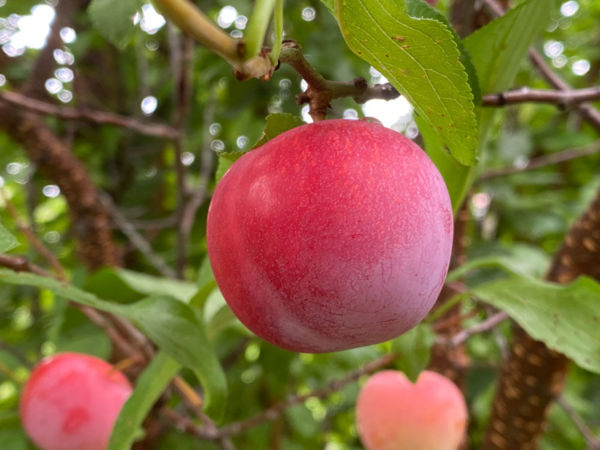An attractive, highly disease-resistant apple, ideal for organic growers.
Bubblegum Plum on Myrobalan (Spring 2025)
You are viewing a tree that will ship in Spring 2025. You can also find trees for Spring 2024.
An aromatic, delicious, disease-resistant plum. Also known as Toka.
Bubblegum grows on a vigorous, upright, dense tree. It is precocious but not self-fertile, and it will need to be partnered with another Japanese plum that blooms early or midseason, such as Waneta or Superior. Bubblegum does, however, have a good reputation as a reliable pollenizer for other trees in these bloom periods. It is also very resistant to black knot.
The plum, ripening about 15 days before Stanley, is small-medium sized, bright red, and intensely aromatic. The yellow flesh is freestone, juicy, and very sweet, with a distinctly candy-like flavor. The perfumed sweetness of Bubblegum never fails to impress, and it has quickly become a favorite in our orchard.
The original name of Bubblegum is Toka and it originates from the prolific breeding experiments of Niels Hansen. In the 1890s, finding himself in South Dakota, Dr. Hansen made it his mission to breed plant varieties that would stand up to the challenge of this cold, dry climate. He collected breeding material from even harsher climates, such as Siberia, and he is now most known for his red-fleshed apples and the Purple-Leaf Sand Cherry, a common ornamental. Toka was the result of Hansen hybridizing Prunus americana with Prunus simonii, the Chinese apricot plum. The offspring has the delicate flavor of the apricot plum bolstered by the cold hardiness and disease resistance of the American plum.
The Fruit
Fruit Type
Category: Plum
Subcategory:
Japanese, Self-Fertile, Cold-Hardy
Fruit Uses & Storage
Uses: fresh eating, jam, baking, canning, freezing, jelly
Storage duration: less than one month (approximate, depending on storage conditions)
Fruit Appearance
Skin color: red
Flesh color: yellow
Fruit Origins
Parentage: Prunus americana x Prunus simonii
Origin: South Dakota
Introduced in: 1911
Introduced by: N.E. Hansen
The Environment
Calendar & Geography
USDA zones: 3 - 8
Chill hours: Not yet determined
Ripening date: Aug 17 (approximate, in New York State) 15 days before Stanley
Tree Height & Spacing
glossary
Rootstock: Myrobalan Rootstock
Rootstock size class: Standard (100% Size)
Tree spacing: See details
Good for wildlife planting? N
Diseases & Pests
glossary
Black Knot: Resistant
Pollination
Pollination Factors
glossary
Bloom group: 3
Is it self-fertile? N
Is it fertile? Y
Ploidy: Diploid
Rootstock size class:
Standard (100% Size)
Pollination Partners
This table shows the first few results from a full search for pollenizers of Bubblegum Plum on Myrobalan. Please see our Pollenizer Search to run other queries and read how the application uses various factors. Also read more about fruit tree pollination.
See all pollination matches for Bubblegum Plum on Myrobalan
Featured Products
A few things we're loving right now...
A full-flavored, freestone white peach.
One of America's oldest apples, good for storage, baking, and cider.
A widely-grown, large, yellow-fleshed nectarine.
























